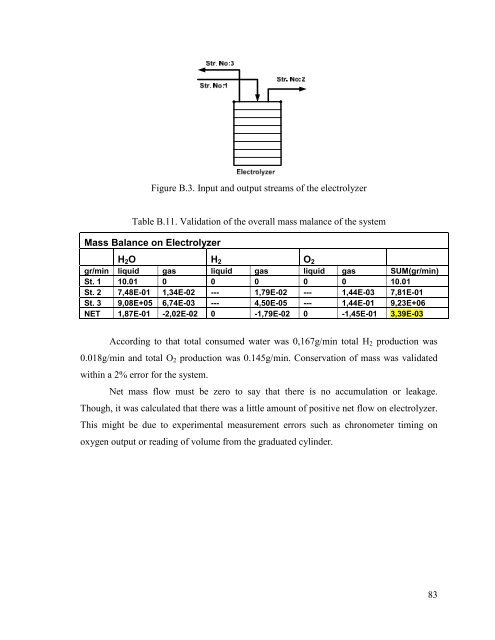hydrogen production from water using solar cells powered nafion ...
hydrogen production from water using solar cells powered nafion ...
hydrogen production from water using solar cells powered nafion ...
Create successful ePaper yourself
Turn your PDF publications into a flip-book with our unique Google optimized e-Paper software.
Figure B.3. Input and output streams of the electrolyzer<br />
Table B.11. Validation of the overall mass malance of the system<br />
Mass Balance on Electrolyzer<br />
H2O H2 O2<br />
gr/min liquid gas liquid gas liquid gas SUM(gr/min)<br />
St. 1 10.01 0 0 0 0 0 10.01<br />
St. 2 7,48E-01 1,34E-02 --- 1,79E-02 --- 1,44E-03 7,81E-01<br />
St. 3 9,08E+05 6,74E-03 --- 4,50E-05 --- 1,44E-01 9,23E+06<br />
NET 1,87E-01 -2,02E-02 0 -1,79E-02 0 -1,45E-01 3,39E-03<br />
According to that total consumed <strong>water</strong> was 0,167g/min total H2 <strong>production</strong> was<br />
0.018g/min and total O2 <strong>production</strong> was 0.145g/min. Conservation of mass was validated<br />
within a 2% error for the system.<br />
Net mass flow must be zero to say that there is no accumulation or leakage.<br />
Though, it was calculated that there was a little amount of positive net flow on electrolyzer.<br />
This might be due to experimental measurement errors such as chronometer timing on<br />
oxygen output or reading of volume <strong>from</strong> the graduated cylinder.<br />
83

















